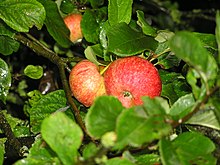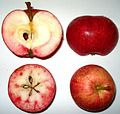Beauty of Bath
| 'Beauty of Bath' | |
|---|---|
 | |
| Species | Malus pumila |
| Cultivar | 'Beauty of Bath' |
| Origin | Bailbrook House near Bath, Somerset, England |
'Beauty of Bath' is a dessert apple cultivar.
It was propagated in 1864 by George Cooling[1][2] and awarded a Royal Horticultural Society First Class Certificate in 1887.[1][3] Sugar 13%, acid 13g/litre, vitamin C 12mg/100g.[4]
'Beauty of Bath' is a very early apple usually cropping in August but can crop as early as July (e.g. in 2011) or last into September. It bruises easily, so is best picked by hand. Fruits can drop early by themselves, often when not completely ripe. Traditionally, straw was placed under the trees to lessen damage to falling fruit.[1][2]
The fruit's taste is sharp at first but sweetens later. The flesh is white but sometimes has a red flush under the skin (approximately 20% occurrence noticed in 2011 in one orchard).
The tree is in flowering group 2 with pale pink blossom and medium to large, blue-green, leaves.
-
 Beauty of Bath (LA 63A) apple, cross-sectioned
Beauty of Bath (LA 63A) apple, cross-sectioned -
 Cross-section exhibiting red flush beneath the skin
Cross-section exhibiting red flush beneath the skin
References

- v
- t
- e
- Malus domestica
- Malus niedzwetzkyana
- Malus sieversii
- Adams Pearmain
- Aia Ilu
- Airlie Red Flesh
- Akane
- Åkerö
- Alkmene
- Allington Pippin
- Ambrosia
- Anna
- Annurca
- Ariane
- Arkansas Black
- Ashmead's Kernel
- Aurora Golden Gala
- Autumn Bough
- Autumn Glory
- Baldwin
- Beacon
- Beauty of Bath
- Belle de Boskoop
- Bellflower
- Ben Davis
- Birgit Bonnier
- Braeburn
- Brina
- Cameo
- Champion
- Civni (Rubens)
- Claygate Pearmain
- Clivia
- Cornish Aromatic
- Cornish Gilliflower
- Cortland
- Cosmic Crisp
- Court Pendu Plat
- Cox's Orange Pippin
- Crimson Gold
- Cripps Red
- Cripps Pink (Pink Lady)
- Delbard Jubilée
- Delbarestivale
- Delrouval
- Devonshire Quarrenden
- Discovery
- Dorsett Golden
- Dougherty
- Duchess of Oldenburg
- Dumelow's Seedling
- Egremont Russet
- Ellison's Orange
- Elstar
- Empire
- Enterprise
- Envy
- Esopus Spitzenburg
- Eva
- EverCrisp
- Fiesta
- Filippa
- Flamenco
- Florina
- Fuji
- Gala
- Gascoyne's Scarlet
- Geheimrat Dr. Oldenburg
- Ginger Gold
- Golden Delicious
- Golden Orange
- Goldspur
- Granny Smith
- Gravenstein
- Grimes Golden
- Haralson
- Hokuto
- Honeycrisp
- Honeygold
- Idared
- Ingrid Marie
- James Grieve
- Jazz
- Jersey Black
- Jonadel
- Jonagold
- Jonathan
- Jubilee
- Julieta
- Jupiter
- Kanzi
- Karmijn de Sonnaville
- King of the Pippins
- Knobby Russet
- Lady Alice
- Laxton's Superb
- Liberty
- Liveland Raspberry
- Lodi
- Lord Lambourne
- Lucombe's Seedling
- Macoun
- McIntosh
- Melba
- Melrose
- Mutsu
- Newtown Pippin
- Nicola
- Opal
- Sciros (Pacific Rose)
- Pam's Delight
- Papirovka
- Paula Red
- Pink Pearl
- Pinova
- Prima
- Pristine
- Rajka
- Ralls Janet
- Rambo
- Rave
- Red Astrachan
- Red Delicious
- Red Pineapple
- Redlove apples
- Rhode Island Greening
- Ribston Pippin
- Roxbury Russet
- Sandow
- Sansa
- Sekai Ichi
- Spartan
- Splendour
- Star of Devon
- Stayman
- Sturmer Pippin
- Summerfree
- Sundowner
- Sunset
- Suntan
- SweeTango
- Taliaferro
- Tartu Rose
- Tentation
- Tompkins King
- Topaz
- Wealthy
- Winesap
- Winston
- Worcester Pearmain
- Wyken Pippin
- York Imperial
- Zestar
- Antonovka
- Bismarck
- Blenheim Orange
- Bramley
- Calville Blanc d'hiver
- Campanino
- Chelmsford Wonder
- Costard
- Creston
- Crimson Bramley
- Flower of Kent
- Golden Noble
- Granny Smith
- Grenadier
- King Byerd
- Manks Codlin
- Newton Wonder
- Norfolk Biffin
- Northern Spy
- Reinette du Canada
- Rome
- Upton Pyne
- White Transparent
- Wolf River
- Brown Snout
- Cap of Liberty
- Chisel Jersey
- Coccagee
- Crimson King
- Dabinett
- Dufflin
- Ellis Bitter
- Foxwhelp
- Golden Russet
- Golden Spire
- Hangdown
- Harrison Cider
- Kingston Black
- Major
- Michelin
- Poveshon
- Redstreak
- Slack-ma-Girdle
- Styre
- Tom Putt
- Woodcock
- Yarlington Mill
- Flamenco
- Goldspur
- Wijcik McIntosh
| Food | |
|---|---|
| Drink |
|
 Apples
Apples Cultivars
Cultivars Production
Production
 | This article about apples or apple cultivars is a stub. You can help Wikipedia by expanding it. |
- v
- t
- e












